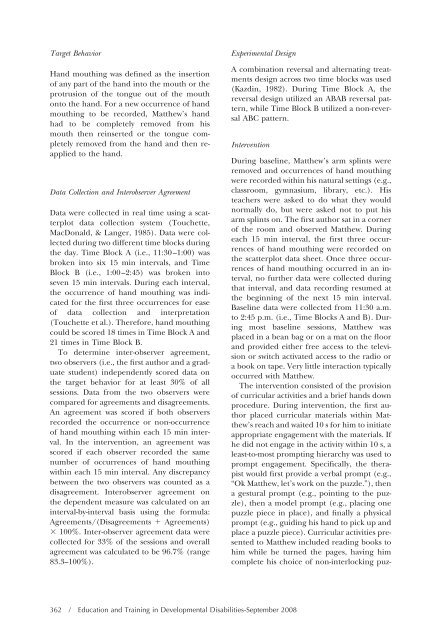Download the Journal (PDF) - Division on Autism and ...
Download the Journal (PDF) - Division on Autism and ...
Download the Journal (PDF) - Division on Autism and ...
You also want an ePaper? Increase the reach of your titles
YUMPU automatically turns print PDFs into web optimized ePapers that Google loves.
Target Behavior<br />
H<strong>and</strong> mouthing was defined as <str<strong>on</strong>g>the</str<strong>on</strong>g> inserti<strong>on</strong><br />
of any part of <str<strong>on</strong>g>the</str<strong>on</strong>g> h<strong>and</strong> into <str<strong>on</strong>g>the</str<strong>on</strong>g> mouth or <str<strong>on</strong>g>the</str<strong>on</strong>g><br />
protrusi<strong>on</strong> of <str<strong>on</strong>g>the</str<strong>on</strong>g> t<strong>on</strong>gue out of <str<strong>on</strong>g>the</str<strong>on</strong>g> mouth<br />
<strong>on</strong>to <str<strong>on</strong>g>the</str<strong>on</strong>g> h<strong>and</strong>. For a new occurrence of h<strong>and</strong><br />
mouthing to be recorded, Mat<str<strong>on</strong>g>the</str<strong>on</strong>g>w’s h<strong>and</strong><br />
had to be completely removed from his<br />
mouth <str<strong>on</strong>g>the</str<strong>on</strong>g>n reinserted or <str<strong>on</strong>g>the</str<strong>on</strong>g> t<strong>on</strong>gue completely<br />
removed from <str<strong>on</strong>g>the</str<strong>on</strong>g> h<strong>and</strong> <strong>and</strong> <str<strong>on</strong>g>the</str<strong>on</strong>g>n reapplied<br />
to <str<strong>on</strong>g>the</str<strong>on</strong>g> h<strong>and</strong>.<br />
Data Collecti<strong>on</strong> <strong>and</strong> Interobserver Agreement<br />
Data were collected in real time using a scatterplot<br />
data collecti<strong>on</strong> system (Touchette,<br />
MacD<strong>on</strong>ald, & Langer, 1985). Data were collected<br />
during two different time blocks during<br />
<str<strong>on</strong>g>the</str<strong>on</strong>g> day. Time Block A (i.e., 11:30–1:00) was<br />
broken into six 15 min intervals, <strong>and</strong> Time<br />
Block B (i.e., 1:00–2:45) was broken into<br />
seven 15 min intervals. During each interval,<br />
<str<strong>on</strong>g>the</str<strong>on</strong>g> occurrence of h<strong>and</strong> mouthing was indicated<br />
for <str<strong>on</strong>g>the</str<strong>on</strong>g> first three occurrences for ease<br />
of data collecti<strong>on</strong> <strong>and</strong> interpretati<strong>on</strong><br />
(Touchette et al.). Therefore, h<strong>and</strong> mouthing<br />
could be scored 18 times in Time Block A <strong>and</strong><br />
21 times in Time Block B.<br />
To determine inter-observer agreement,<br />
two observers (i.e., <str<strong>on</strong>g>the</str<strong>on</strong>g> first author <strong>and</strong> a graduate<br />
student) independently scored data <strong>on</strong><br />
<str<strong>on</strong>g>the</str<strong>on</strong>g> target behavior for at least 30% of all<br />
sessi<strong>on</strong>s. Data from <str<strong>on</strong>g>the</str<strong>on</strong>g> two observers were<br />
compared for agreements <strong>and</strong> disagreements.<br />
An agreement was scored if both observers<br />
recorded <str<strong>on</strong>g>the</str<strong>on</strong>g> occurrence or n<strong>on</strong>-occurrence<br />
of h<strong>and</strong> mouthing within each 15 min interval.<br />
In <str<strong>on</strong>g>the</str<strong>on</strong>g> interventi<strong>on</strong>, an agreement was<br />
scored if each observer recorded <str<strong>on</strong>g>the</str<strong>on</strong>g> same<br />
number of occurrences of h<strong>and</strong> mouthing<br />
within each 15 min interval. Any discrepancy<br />
between <str<strong>on</strong>g>the</str<strong>on</strong>g> two observers was counted as a<br />
disagreement. Interobserver agreement <strong>on</strong><br />
<str<strong>on</strong>g>the</str<strong>on</strong>g> dependent measure was calculated <strong>on</strong> an<br />
interval-by-interval basis using <str<strong>on</strong>g>the</str<strong>on</strong>g> formula:<br />
Agreements/(Disagreements Agreements)<br />
100%. Inter-observer agreement data were<br />
collected for 33% of <str<strong>on</strong>g>the</str<strong>on</strong>g> sessi<strong>on</strong>s <strong>and</strong> overall<br />
agreement was calculated to be 96.7% (range<br />
83.3–100%).<br />
Experimental Design<br />
A combinati<strong>on</strong> reversal <strong>and</strong> alternating treatments<br />
design across two time blocks was used<br />
(Kazdin, 1982). During Time Block A, <str<strong>on</strong>g>the</str<strong>on</strong>g><br />
reversal design utilized an ABAB reversal pattern,<br />
while Time Block B utilized a n<strong>on</strong>-reversal<br />
ABC pattern.<br />
Interventi<strong>on</strong><br />
362 / Educati<strong>on</strong> <strong>and</strong> Training in Developmental Disabilities-September 2008<br />
During baseline, Mat<str<strong>on</strong>g>the</str<strong>on</strong>g>w’s arm splints were<br />
removed <strong>and</strong> occurrences of h<strong>and</strong> mouthing<br />
were recorded within his natural settings (e.g.,<br />
classroom, gymnasium, library, etc.). His<br />
teachers were asked to do what <str<strong>on</strong>g>the</str<strong>on</strong>g>y would<br />
normally do, but were asked not to put his<br />
arm splints <strong>on</strong>. The first author sat in a corner<br />
of <str<strong>on</strong>g>the</str<strong>on</strong>g> room <strong>and</strong> observed Mat<str<strong>on</strong>g>the</str<strong>on</strong>g>w. During<br />
each 15 min interval, <str<strong>on</strong>g>the</str<strong>on</strong>g> first three occurrences<br />
of h<strong>and</strong> mouthing were recorded <strong>on</strong><br />
<str<strong>on</strong>g>the</str<strong>on</strong>g> scatterplot data sheet. Once three occurrences<br />
of h<strong>and</strong> mouthing occurred in an interval,<br />
no fur<str<strong>on</strong>g>the</str<strong>on</strong>g>r data were collected during<br />
that interval, <strong>and</strong> data recording resumed at<br />
<str<strong>on</strong>g>the</str<strong>on</strong>g> beginning of <str<strong>on</strong>g>the</str<strong>on</strong>g> next 15 min interval.<br />
Baseline data were collected from 11:30 a.m.<br />
to 2:45 p.m. (i.e., Time Blocks A <strong>and</strong> B). During<br />
most baseline sessi<strong>on</strong>s, Mat<str<strong>on</strong>g>the</str<strong>on</strong>g>w was<br />
placed in a bean bag or <strong>on</strong> a mat <strong>on</strong> <str<strong>on</strong>g>the</str<strong>on</strong>g> floor<br />
<strong>and</strong> provided ei<str<strong>on</strong>g>the</str<strong>on</strong>g>r free access to <str<strong>on</strong>g>the</str<strong>on</strong>g> televisi<strong>on</strong><br />
or switch activated access to <str<strong>on</strong>g>the</str<strong>on</strong>g> radio or<br />
a book <strong>on</strong> tape. Very little interacti<strong>on</strong> typically<br />
occurred with Mat<str<strong>on</strong>g>the</str<strong>on</strong>g>w.<br />
The interventi<strong>on</strong> c<strong>on</strong>sisted of <str<strong>on</strong>g>the</str<strong>on</strong>g> provisi<strong>on</strong><br />
of curricular activities <strong>and</strong> a brief h<strong>and</strong>s down<br />
procedure. During interventi<strong>on</strong>, <str<strong>on</strong>g>the</str<strong>on</strong>g> first author<br />
placed curricular materials within Mat<str<strong>on</strong>g>the</str<strong>on</strong>g>w’s<br />
reach <strong>and</strong> waited 10 s for him to initiate<br />
appropriate engagement with <str<strong>on</strong>g>the</str<strong>on</strong>g> materials. If<br />
he did not engage in <str<strong>on</strong>g>the</str<strong>on</strong>g> activity within 10 s, a<br />
least-to-most prompting hierarchy was used to<br />
prompt engagement. Specifically, <str<strong>on</strong>g>the</str<strong>on</strong>g> <str<strong>on</strong>g>the</str<strong>on</strong>g>rapist<br />
would first provide a verbal prompt (e.g.,<br />
“Ok Mat<str<strong>on</strong>g>the</str<strong>on</strong>g>w, let’s work <strong>on</strong> <str<strong>on</strong>g>the</str<strong>on</strong>g> puzzle.”), <str<strong>on</strong>g>the</str<strong>on</strong>g>n<br />
a gestural prompt (e.g., pointing to <str<strong>on</strong>g>the</str<strong>on</strong>g> puzzle),<br />
<str<strong>on</strong>g>the</str<strong>on</strong>g>n a model prompt (e.g., placing <strong>on</strong>e<br />
puzzle piece in place), <strong>and</strong> finally a physical<br />
prompt (e.g., guiding his h<strong>and</strong> to pick up <strong>and</strong><br />
place a puzzle piece). Curricular activities presented<br />
to Mat<str<strong>on</strong>g>the</str<strong>on</strong>g>w included reading books to<br />
him while he turned <str<strong>on</strong>g>the</str<strong>on</strong>g> pages, having him<br />
complete his choice of n<strong>on</strong>-interlocking puz-
















